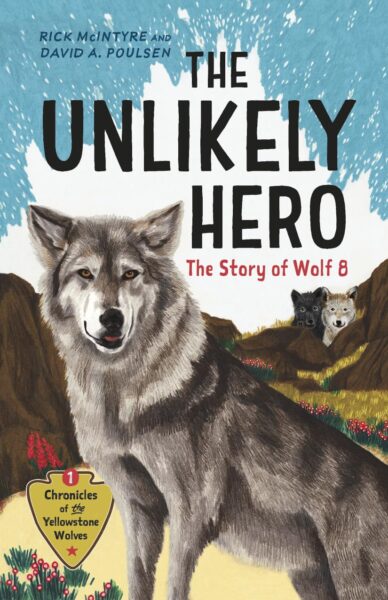The Unlikely Hero tells the action and adventure story of one of Yellowstone’s most famous animals, Wolf 8: a runt of the litter who surprised scientists by becoming a powerful leader.
Newly reintroduced along with his pack to Yellowstone National Park, Wolf 8 struggles at first. Small and bullied by his siblings, he must learn to fend for himself in his new home. Can little 8 rise to the occasion? Is he ready to be an alpha wolf?
Based on McIntyre’s own sightings of Wolf 8, this is a rare glimpse into the fascinating world of wolves and a coming-of-age story for underdogs everywhere.
Reading a story based on actual wolf packs in Yellowstone National Park, written in the third-person point of view of the wolves themselves, is refreshing, original and a delightful educational experience. Even better, a foremost wolf expert intersperses the wolves’ stories with sidebars loaded with fascinating facts and insights, making this both a fiction and nonfiction book, and barely even fiction since most of the story’s incidents actually happened (observed by wolf experts tailing them day and night for many years).
So, The Unlikely Hero offers up nature, adventure, survival and wolf-kingdom insights like no other book, and it’s aimed specifically at middle-grade readers thanks to the talented pen of David A. Poulsen – a Canadian rancher and author of 28 books, many of them award-winning novels for youth.
Poulsen teamed up with Rick McIntyre, a retired National Park Service ranger who has watched wolves in America’s national parks for more than 44 years, 28 of those in Yellowstone, where he accumulated more than 100,000 wolf sightings, worked on the Yellowstone Wolf Reintroduction Project and educated the public about the park’s wolves, including by writing several books for adult readers.
All that having been said, there are a few aspects that make this book slightly awkward. First, we’re not with the “main character,” Wolf 8, throughout the story, nor are we always in his point of view. We meet his partner, children, step-children – and sometimes “hang out” with them before returning to him. Second, an omnipotent narrator’s point of view piggybacks (wolf-backs?) on the wolves’ point of view, a necessity given that Wolf 8 can’t really tell us how old he is in human years, how much elk weigh or which rangers are watching him. That switch back and forth is a little difficult to get used to:
8 often traveled by himself, partly because his brothers still sometimes ganged up on him. 8 had no way of knowing it, but he’d just had his first birthday. That meant he was no longer a pup but a yearling, which made him about the same age as a human 12-year-old.
Sometimes after his brothers had beaten up on him, his mother would gently lick 8 on the face and in the places where he had been bitten. That always made him feel better…
The six Crystal Creek wolves continued on their way. It wasn’t long before the two adults spotted a herd of elk. Elk are large — the cows weigh approximately 500 pounds (225 kilograms) and the bulls can weigh up to 700 pounds (320 kilograms). But while they are much bigger than wolves, they are considerably smaller than bison and, as a result, are a lot more manageable as prey. Back in Alberta, 8’s parents had specialized in hunting elk…
The Crystal Creek wolves were not alone in the section of Yellowstone that made up their home. There were other animals, of course, but there were also humans. Among them were the rangers and biologists whose job it was to observe 8 and his family and the other wolves that had been released into Yellowstone National Park. One of those rangers was Rick McIntyre. Rick was born in Lowell, Massachusetts. He and his family lived…
Finally, fictionalizing real events almost always makes for a slightly less gripping read than one made up from scratch; the plot points, actions, pacing and character changes aren’t always ideally aligned. So, even though we get plenty of action – duels between wolves and their competitors (from bears to birds and other packs) – and up-close family scenes that teach us much, and even though we follow Wolf 8 from puppyhood to death, we need to enroll a little more patience than with other novels, animal-told or not.
But back to the nonfiction sidebars. Kids who love learning facts will relish these. Here are some examples:
One term you have already encountered and will see a lot more of in this book is alpha. The alpha male and female are the highest-ranking wolves within the pack. But the leader of the pack is the alpha female, a critical job requiring intelligence, leadership skills and courage. Alpha female wolves are tremendously important to the success of the pack. Beta females and males are secondary to the alphas. ⋆ RICK
Wolf parents will often feed their pups by regurgitation — that is, bringing food they have stored in their stomachs back up into their mouths and then spitting it out onto the ground for the pups to eat. The pups will run to the returning hunters and lick their faces. The licking will trigger the regurgitation, which is not the same as nausea or throwing up. The adults are not sick; they are just providing food for the youngest members of the family. When pet dogs lick the faces of their human friends when they return home, it is a reminder that their distant ancestors were wolves. ⋆ RICK
Occasionally Rami (a school-visiting tame wolf) would pick out a child she wanted to meet. If that happened, the student could pet her. Sometimes it was a girl Rami chose to befriend, and other times a boy. It might be a young child or an older one. Kent began to ask the teachers if there was anything special about the student the wolf had chosen. The teachers nearly always said the wolf had gone to the most picked-on boy or girl in the school. ⋆ RICK
In summary, this book is incredibly rich in knowledge about wolves and the natural environment, as well as fun and gripping to read. It’s an unusual treat that many a middle-grade reader will lap up.
– Pam Withers


